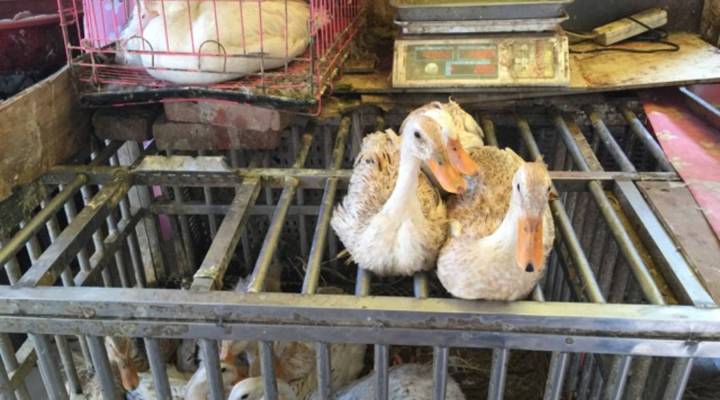
The Chinese lake that’s ground zero for the bird flu

It’s early spring, and hundreds of thousands of birds on Poyang Lake will soon migrate as far north as the Arctic Ocean. More migratory birds spend their winters here, on China’s largest freshwater lake, than anywhere else in Asia. But they’re not the only birds here.
“There are farmers raising all sorts of poultry here, too,” says Nanji Wetland Nature Reserve manager Wan Songxian. “At this time of year, the wild birds look for food on the farms, and there’s a lot of contact between wild animals and domesticated poultry.”
In other words, now’s the ideal time for the avian influenza virus to spread. A few miles away is the ideal place: A rice paddy filled with thousands of domesticated ducks. From here, the virus has the potential to spread.
“It’s going to move from wild birds into a poultry system, where it has a capacity to mutate very quickly and into a different form,” says United States Geological Service Wildlife Ecologist Diann Prosser. Prosser has visited Poyang Lake several times on research trips. She says it’s a cauldron for brewing new strains of flu. She says once it’s inside domesticated ducks that live on farms surrounding the lake, the virus can mutate from a non-lethal form into a lethal one.
“Meaning that the domestic birds may have that same strain of highly pathogenic avian influenza virus or one that’s slightly evolved. And then it’s able to go back into the wild birds and infect them.”
Infected birds then carry it thousands of miles away.
That’s what happened around fifteen years ago when the deadly strain H5N1 spread from a lake in northern China to Europe and Africa, killing hundreds of millions of birds and hundreds of humans, causing twenty billion dollars-worth of damage. Last year, a different strain of the avian influenza wiped out nearly 50 million birds in the US at the cost of half a billion dollars to America’s poultry industry before authorities got it under control.
That’s why scientists from around the world like Prosser are worried about Poyang Lake.
“In the Poyang Lake region there’s almost 9 million people,” says Prosser. “Plus you’ve got this amazing situation, dynamic and like mixing bowl of people and wildlife and birds, with all different levels of biosecurity. From the backyard farm to the very large, highly commercialized bio secure farm.”

Poyang Lake as seen on Google Maps.
The Min family farm on the shores of Poyang Lake is more of a backyard type, with acres of rice paddies and thousands of ducks ranging freely. The sister and brother team Min Donglan and Min Xiaoping say they’ve been worried about the bird flu.
“Of course we’re worried! When wild birds come here, we’re not allowed to chase them away or shoot them – they’re protected animals!” Min Donglan shouts. “Years ago on TV, we heard it was spreading near here, so we kept our ducks inside. Each duck is worth five dollars. If one of them gets the flu, all of them could die and we’d lose everything.”
Learning about a local spread of the virus over television raises the question: does the government ever visit them to inspect their farm or to help them prevent the spread of the virus?
“No, nothing at all,” Min says. “The government doesn’t do anything for us– nobody’s in charge.”
“Yes, they should do more. But, it’s never happened,” says Guo Fusheng, who works at the United Nations Food and Agriculral Organization in Beijing. He admits China’s government isn’t doing enough to prevent the spread of the virus. “They did samplings on Poyang Lake, but it’s not a systematic research.”
China has required poultry farmers to vaccinate their flocks, but enforcement, says Guo, is lax. Quarantining infected poultry, as US farmers were forced to do last year, is a challenge in a country where small-scale farms are the norm. China has, though, swiftly shut down live bird markets when the virus spread to humans.
At a market in the city of Nanchang, just an hour’s drive from the lake, ducks, chickens, pigeons, and other animals lie in cages next to each other – an ideal breeding ground, say scientists, for deadly strains of the bird flu to spread to humans. Duck vendor Li Peixiang disagrees. “No, no, no, no! There’s no bird flu here! Never!” she insists.
Perhaps. But two years ago two people died of yet another a strain of flu that had never been fatal to humans. Chinese health detectives traced the virus to live poultry markets in Nanchang. Separate research identified Poyang Lake as a major source of that strain. And risk of more flu strains coming out of China will likely grow. Chinese consumers prefer to buy live poultry, partly due to a deep distrust of the quality of the meat from factory farms. And as China’s economy continues to grow, the demand for meat will go up, and so will the risk for the spread of new strains of avian influenza.
There’s a lot happening in the world. Through it all, Marketplace is here for you.
You rely on Marketplace to break down the world’s events and tell you how it affects you in a fact-based, approachable way. We rely on your financial support to keep making that possible.
Your donation today powers the independent journalism that you rely on. For just $5/month, you can help sustain Marketplace so we can keep reporting on the things that matter to you.












